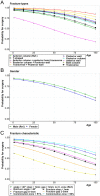Evaluation of decision-making in the treatment of acetabular fractures
- PMID: 35073514
- PMCID: PMC8788147
- DOI: 10.1530/EOR-20-0149
Evaluation of decision-making in the treatment of acetabular fractures
Abstract
Treatment of acetabular fractures is challenging and risky, especially when surgery is performed. Yet, stability and congruity of the hip joint need to be achieved to ensure early mobilization, painlessness, and good function. Therefore, coming up with an accurate decision, whether surgical treatment is indicated or not, is the key to successful therapy. Data from the German pelvic Trauma Registry (n = 4213) was evaluated retrospectively, especially regarding predictors for surgery. Furthermore, a logistic regression model with surgical treatment as the dependent variable was established. In total, 25.8% of all registered patients suffered from an acetabular fracture and 61.9% of them underwent surgery. The fracture classification is important for the indication of surgical therapy. Anterior wall fractures were treated surgically in 10.2%, and posterior column plus posterior wall fractures were operated on in 90.2%. Also, larger fracture gaps were treated surgically more often than fractures with smaller gaps (>3 mm 84.4%, <1 mm 20%). In total, 51.4% of women and 66.0% of men underwent surgery. Apart from the injury severity score (ISS), factors that characterize the overall picture of the injury were of no importance for the indication of a surgical therapy (isolated pelvic fracture: 62.0%, polytrauma: 58.8%). The most frequent reason for non-operative treatment was 'minimal displacement' in 42.2%. Besides fracture classification and fracture characteristics, no factors characterizing the overall injury, except for the ISS, and unexpectedly gender, are important for making a treatment decision. Further studies are needed to determine the relevance of these factors, and whether they should be used for the decision-making process, in particular surgeons with less experience in pelvic surgery, can orient themselves to.
Keywords: acetabular fracture; age; epidemiology; gender medicine; pelvis; predictors for surgery.
Figures


References
-
- Letournel E, Judet R. Fractures of the Acetabulum. Ed Elson RA.Berlin Heidelberg: Springer, 1993. (10.1007/978-3-642-75435-7) - DOI
Publication types
LinkOut - more resources
Full Text Sources

